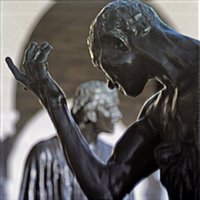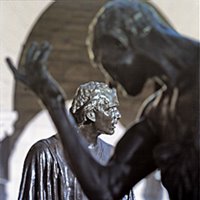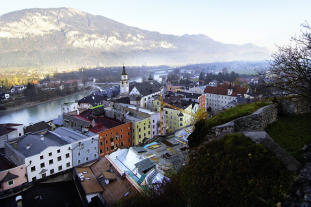The Internet of Things
The World Summit on the Information Society which met in Tunis this November has produced a report, "The Internet of Things."
"Today, in the 2000s, we are heading into a new era of ubiquity, where the “users” of the internet will be counted in billions and where humans may become the minority as generators and receivers of traffic.
Instead, most of the traffic will flow between devices and all kinds of “things”, thereby creating a much wider and more complex “Internet of Things”"
"In this way, the “virtual world” would “map” the “real world”, given that everything in our physical environment would have its own identity (a passport of sorts) in virtual cyberspace. This will enable communication and interaction between people and things, and between things, on a staggering scale."
Four key technology areas constitute the backbone of the Internet of Things miniaturization, automation, intelligence and mobility.
What are the challenges to implementing the internet of things?
Well, maybe people do not want their refrigerator ordering their food for them. Maybe people would not like their car to decide how fast they should drive. Maybe people would be uncomfortable with their local shopping center knowing that they had a bad day and would feel better if they treated themselves to something special.
Give up your notions of privacy. There will be none. You personally will not be tracked so much as all of your 'things' and everything that you interact with. So your privacy will be breeched only in so far as you think your 'things' are part of you.
We will adapt easily. Just as today people get uncomfortable if they do not have a cell phone with them, so too they will feel like they are alone in the wilderness if the things around them do not recognize them and greet them by name.
The-Internet-of-Things-2005.pdf (pdf)
Light Field Camera Always In Focus


 Shown: Near focus - far focus - all in focus
Shown: Near focus - far focus - all in focusAnne Strehlow
Ren Ng, a computer science graduate student in the lab of Pat Hanrahan, the Canon USA Professor in the School of Engineering,
Stanford University, has developed a "light field camera" capable of producing photographs in which subjects at every depth appear in finely tuned focus.
"Currently, cameras have to make decisions about the focus before taking the exposure, which engineering-wise can be very difficult," said Ng. "With the light field camera, you can take one exposure, capture a lot more information about the light and make focusing decisions after you've already taken the shot. It is more flexible."
The light field camera, sometimes referred to as a "plenoptic camera," looks and operates exactly like an ordinary handheld digital camera.
The light field camera adds an additional element—a microlens array—inserted between the main lens and the photosensor. Resembling the multi-faceted compound eye of an insect, the microlens array is a square panel composed of nearly 90,000 miniature lenses. Each lenslet separates back out the converged light rays received from the main lens before they hit the photosensor and changes the way the light information is digitally recorded. Custom processing software manipulates this "expanded light field" and traces where each ray would have landed if the camera had been focused at many different depths. The final output is a synthetic image in which the subjects have been digitally refocused.
Computer scientists create 'light field camera' banishing fuzzy photos
Living Bacterial Photographs
Using Petri dishes full of genetically engineered E. coli instead of photo paper, students at
The University of Texas at Austin and
UCSF successfully created the first-ever bacterial photographs.
Their work is published in this week's issue of Nature (Nov. 24, 2005), which is devoted entirely to the emerging field of synthetic biology.
The students produced the innovative bacterial images and a bacterial camera as part of MIT's intercollegiate Genetically Engineered Machine (iGEM) competition, which encourages students to build simple biological machines.
"The goal of the contest was to build bacteria that could do very simple computing," says Dr. Edward Marcotte, one of the students' faculty advisers and associate professor of biochemistry at The
University of Texas at Austin. "This is a great example of the emergent field of synthetic biology--using principles of engineering in biology."
The students produced ghostlike, living photos of many things, including themselves, their advisers and The University of Texas Tower.
The bacterial photos were created by projecting light on "biological film"--billions of genetically engineered E. coli growing in dishes of agar, a standard jello-like growth medium for bacteria.
Like pixels on a computer screen switching between white and black, each bacterium either produced black pigment or didn't, based on whether it was growing in a light or dark place in the dish. The resulting images are a collection of all the bacteria responding to the pattern of light.
The light receptor was connected to a system in the bacteria that makes pigments. When light strikes the new receptor, it turns off a gene that ultimately controls the production of a colored compound in the bacteria.
The device projects the pattern of light--like an image of one of the Texas students' co-advisers, Dr. Andy "Escherichia" Ellington--onto the dish of bacteria growing at body temperature in an incubator. After about 12-15 hours of exposure (the time it takes for a bacterial population to grow and fill the Petri dish), the light projector is removed.
What's left is a living photograph.
New Scientist
Austrian village to bring in the light
Company to use mirror trick to enlighten Austrian village
Small town is hoping reflector technology will bring sunlight to its dark winters
By GEORGE JAHN
Associated Press
RATTENBERG, AUSTRIA - The sun has stopped shining in Rattenberg. But with the aid of a few mirrors, the winter darkness that grips this small town could soon be brightened up with pockets of sunshine.
That's because sunshine is plentiful less than a 10 minutes' walk from the town and from Rat Mountain, the 3,000-foot hill that blocks its sunlight between November and February each year.
The solution: 30 heliostats, essentially rotating mirrors, mounted on a hillside to grab sunshine off reflectors from the neighboring village of Kramsach.
Bartenbach Lichtlabor GmbH, the Austrian company behind the idea, has already used mirrors for lighting projects around the world — sunshine into European basements and railroad stations or nighttime illumination of mosques in Saudi Arabia and Malaysia.

It's costly, however. The European Union is footing half the $2.4 million bill, and the company says it will pay the $600,000 cost of planning the project, gambling that success will attract more business.
Rattenberg was built between the hill to the south and the Inn River to the north starting in the 1300s for protection against marauders. Back then, lack of sunshine was a small price to pay for security.
Other suggestions for improving the village included removing the mountain, changing the axis of rotation of the Earth or treating the drinking water with antidepressants. Some have even suggested negotiating with the marauders so they do not need to live there anymore. Said one resident, "700 years is long enough to live in the dark."Chron.com | Company to use mirror trick to enlighten Austrian village
Comic books shadow how we react to threats
In times of social danger and economic turmoil, many psychologists believe that people become more aggressive, more conventional, and less interested in feelings and emotions. A new study published in the latest issue of Political Psychology finds that comic book characters do these things as well. In times of higher threat, i.e. the events of 1979 which included the Iran hostage crisis, comic books contained more aggressive imagery, focused on male characters, and were less introspective. The authors reviewed comic books published between 1978 -1992 frame by frame to judge the amount of violence and conventionalism drawn, the number of women and minorities in speaking or subordinate roles, portrayal of wrongdoing by the authorities, and the amount of reflection (thought in balloons rather than dialogue). In general, the authors found that women spoke less and a significantly greater number of panels were devoted to aggression during high threat periods.
The authors reviewed eight Marvel comic books that are still published today. These titles included four titles that featured more conventional heroes that represent American virtues like U.S. patriotism (Captain America) and the everyman (Spider-Man). The other four heroes were less conventional with themes such as persecution by society (X-men) and a vigilante who lives in an "amoral urban hell" (Daredevil). When compared against their own sales, the unconventional titles sold more copies during the low-threat times compared to the high-threat times; whereas the conventional hero sales remained flat. "As an aspect of popular culture, comic books have always reflected the historical time period in which they were produced," author Bill Peterson explains.
Comic books shadow how we react to threats
See Through Walls
By: Willie D. Jones
Portable radar devices see through walls and report what's inside
Through-the-wall radar devices that are lightweight, portable, and able to focus up to 20 or 30 meters ahead are available to municipalities and law enforcement agencies. Two such devices are
RadarVision, built by
Time Domain Corp., of Huntsville, Ala., and the
Prism 100, from
Cambridge Consultants Ltd., in Cambridge, England. Both rely on ultrawideband, a fairly new technology known mainly as a promising high-speed, low-power radio communications transmission technique.
Both devices can detect the presence of inanimate objects through the wall, but only motion (in the form of a moving blob of color on their built-in color screens) is shown to the user. The devices are so sensitive that even if someone on the other side of the wall is sitting still, the machines can detect the rise and fall of the person's chest with each breath.

What the user sees is a plain view of what lies on the other side of the wall, but seen onscreen from above. An optional mode shows the space on the other side of the wall the way it would appear from the side.
No Place to Hide







